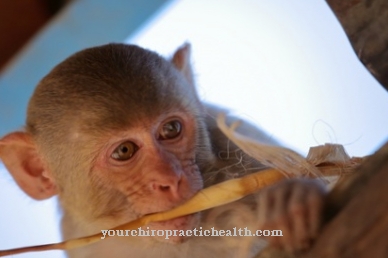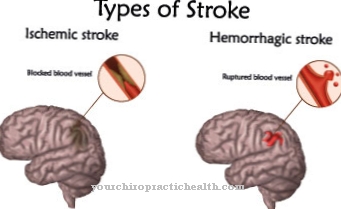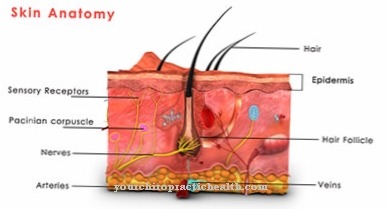Changes in the human genome, i.e. the totality of all genes, can manifest themselves in beneficial, but mostly in disadvantageous symptoms. The aim here is to explain how gene mutation occurs, how the diagnosis is made, what type of symptoms can be and how medicine treats and treats them. A general statement is due to the multitude of possibilities of the Gene mutation not possible.
What is gene mutation?

© Dan Race - stock.adobe.com
A gene is a part of the DNA that is responsible for exactly one characteristic. For example, the part of DNA that determines body size or that encodes eye color is a gene. DNA is understood to be the base-containing threads in the cell nucleus that carry all the information about the structure of a living being. The totality of all genes in a living being is called the genome.
The term gene mutation is now a combination of the word gene and the word mutation, which comes from the Latin "mutare" for "to change". By definition, it is a - mostly sudden - change in the genetic make-up.
causes
First and foremost, it should be noted that nobody can contribute to or against a gene mutation. Usually this happens randomly and suddenly. It is interesting to think that without gene mutations, evolution would not have taken place in the world.
Gene mutations meant that certain living beings were better adapted to the environmental conditions than others and were therefore better able to assert themselves, that is, to reproduce. Gene mutations that do not cause symptoms are usually not noticeable, the carrier does not notice them or they may even have advantages that they are not aware of.
However, there is some evidence in medical and biological research that certain substances in the environment (poisons such as nicotine, acids) tend to trigger gene mutations. In meiosis, the division of germ cells (provision of fertilizable sperm and egg cells), older age plays a role for mutations that are carried by the developing child. X-rays and radioactive radiation as well as heat and cold shocks are also possible triggers for mutations.
Symptoms, ailments & signs
If it is a matter of a mutation in a body cell, all body cells that result from division are affected by the mutation. This can sometimes be negative, but does not have to be. It always depends on how much tissue in the body is affected by the mutation.
However, if the germ cells are mutated as described above, every single cell in the body is affected by the mutation. It is important to understand that each and every one of the billions of cells contains the same identical information. In order to change or correct a genetic defect of any kind, one would have to intervene in each of these vast numbers of cells, which is impossible for reasons that are of course understandable.
The symptoms range from the most severe physical and / or mental disabilities to moderate impairments to complete freedom from symptoms, depending on which gene the mutation occurred on.
It stands to reason that a mutation in the gene for eye color will not cause symptoms, but one that affects the function of the insulin-producing islet cells in the pancreas will. A statement about general symptoms is therefore not possible here.
diagnosis
If a mutation is suspected, cells of the developing child can be examined for completeness or changes in the genome using amniotic fluid puncture and other methods - generally risk-free for the child - in the womb. In children or adults, the DNA is usually analyzed by a cell in the oral mucosa.
A person's DNA forms 23 pairs of chromosomes, which differ in shape and pattern. Complicated laboratory analysis will reveal abnormalities. Many common mutations are known to medicine, but new ones with new symptoms keep appearing. Once the diagnosis has been made, the course of the disease, if any, is monitored.
Complications
Since a gene mutation takes place in the genome and thus has a serious influence on the development, growth and metabolism of the individual, the complications are sometimes serious. A gene mutation can lead to the deactivation or incorrect activation of entire gene segments. Over and underproduction of enzymes and proteins are usually the result, which in the worst case leads to malformations.
If these malformations are serious, but the person is still viable, organ damage and an impairment of intellectual development can usually be determined. In mild cases of a gene mutation that only inhibits small areas of the metabolism, food intolerance or severe allergies can be the result.
In many cases a gene mutation during the development of the zygote means the death of the organism. This is the case when the mutation affects development so massively that the functionalities of the individual organs and the correct growth can no longer succeed.
Carriers of gene mutations can experience various effects from them, which usually show at the latest from birth. Serious organ malformations and subsequent growth disorders are particularly common effects that can be counteracted surgically. Complications arise in this context regardless of medical treatment, as they are genetic.
When should you go to the doctor?
A visit to the doctor is required if a gene mutation occurs. Since the symptoms of this disease depend very much on its severity, no general prediction about the symptoms is possible. A gene mutation is, however, often detected before the child is born.
Various doctors must also be consulted after the birth, for example if the child suffers from mental or motor disabilities. Various hearing or vision problems should also be examined by a doctor. The earlier the gene mutation is detected, the better the further course of the disease.
A doctor should also be consulted in the event of a gene mutation if this leads to psychological complaints or to concentration problems. This can avoid further complaints and complications in adulthood of the person concerned. Since the parents or relatives themselves often suffer from psychological complaints, care should be sought for them too. Psychological treatment is also recommended if the pregnancy is terminated due to the gene mutation.
Doctors & therapists in your area
Treatment & Therapy
Treatment or therapy for a gene mutation is always based on the symptoms. Depending on which organ, which tissue or which system is affected, the therapy must be based on it. For this reason, a clear diagnosis and long-term observation are necessary. Only then does the decision for a particular therapy arise.
Therapy usually consists of administering medication to the person affected by substituting substances that the body cannot produce. Another form of therapy takes effect where the person concerned cannot tolerate certain things by learning to do without them or to avoid them. A third type of therapy is a physiotherapeutic one in which the person concerned learns to compensate for non-functioning body systems.
Outlook & forecast
The mutation of genes is an unalterable process of the organism. It arises in the womb and cannot be corrected. Since human genetics cannot be interfered with for legal reasons, there are currently no changes in the genetic material. The gene mutation can cause a variety of different diseases or disorders.
Most present themselves as a disadvantage over the course of life or are life threatening. Improvements in health are only rarely documented through the gene mutation. With some mutations there is no chance of survival for those affected. In these cases, stillbirth can occur or life expectancy is a few hours, weeks or years.
Medical care provides for timely diagnosis. If the gene mutation is detected early, relatives can make preparations for the necessary care for the possible offspring or, in the case of severe genetic disorders, decide on an abortion.
Treatment of the patient is geared towards alleviating the individual symptoms. Through the administration of medication, early intervention programs and surgical interventions, the potential possibilities of the patient should be promoted and existing damage minimized. The main focus is on optimizing the quality of life and extending life expectancy, as a cure is not possible due to legal requirements.
prevention
Only by avoiding the mutagens, i.e. the triggering factors as described above, can the probability of a gene mutation be reduced. Most mutations are either automatically repaired by the body or the affected cells die.
The gene mutation is also one of the most common causes of miscarriage - in this case the organism is not viable due to a gene mutation. It is hardly possible to actively contribute for or against a gene mutation.
Aftercare
There is no follow-up care for a gene mutation per se. This is due to the fact that a gene mutation is a process inside the genome, which is beyond the medical reach. Either the mutation is innate and leads to more or less serious effects. Or the gene mutation is acquired, which is only relevant for germ cells. However, proving this is difficult.
In the case of gene mutations that have a high chance of inheritance and lead to disease, family planning can be part of individual follow-up care. Accordingly, those affected can voluntarily refrain from fathering children with the same mutation. Therapy is only possible in very few cases. The individual case must be weighed up here.
Otherwise, follow-up measures relate to the respective diseases and syndromes that may be related to gene mutations. These include, for example, follow-up care for sickle cell anemia or hemophilia. Still other conditions related to gene mutations do not require any action at all.
This applies, for example, to color vision deficiency or the heterozygous variant of sickle cell anemia. The latter leads to almost no restrictions, but brings resistance to malaria with it. Most gene mutations, however, remain unnoticed and can therefore neither be treated, nor is follow-up care appropriate.
You can do that yourself
The possibilities for a gene mutation to help itself depend on the damaged genes and their effects on the organism. Normally, the patient cannot change the disease on his own. The self-healing powers have no influence on genetic mispositions.
Often the help in everyday life lies in learning how to deal with the gene mutation. This often applies to the patient and their close relatives. Well-being and quality of life should be promoted and stabilized in spite of all impairments. Stress relief measures help immensely. This can be done through discussions with therapists, friends or relatives.
The mutual exchange gives a feeling of security and gives new life force. In addition, relaxation methods help to build or maintain mental strength. In self-help groups, those affected can exchange ideas and report on their everyday experiences. Tips and advice for an improved lifestyle help and give you new confidence. They also encourage optimistic thinking.
Patients with a gene mutation are often dependent on everyday help because they cannot carry out many processes on their own. Relatives should therefore focus early on on activities or activities in which the sick person has a good chance of success. Self-esteem is built up and promoted by recognizing one's own skills.

.jpg)

.jpg)























